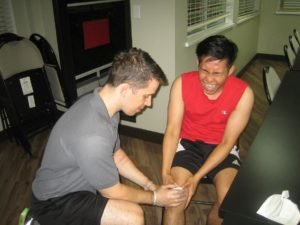Blood blisters are similar to fluid-filled blisters, however, as the name suggests, they are filled with blood. The skin has two layers, the epidermis, the top layer, and the dermis, the bottom layer. Blood vessels, specifically the capillaries, are only present in the dermis. In regular blisters, the accumulation of clear bodily fluids happens beneath the epidermis but above the dermis and while the same is true for blood blisters, in the case of blood blisters, there is a considerable amount of pressure that causes a deeper injury. The added pressure causes the bursting of the capillaries and the bleeding seeps into the blister. Thus, that discoloration is often red, purplish, blackish, which is the color of blood. Moreover, because of the excess pressure, the most frequent sites of blood blisters are the joints and bony prominences. Bony prominences include the heel, the ball of the foot, the toes and the fingers.
Causes of Blood Blisters
Blood blisters occur less frequently than regular blisters. They can form with poor fitting shoes or when one does activities such as weightlifting, baseball and bike riding. The following list are the most common causes of blood blisters:
- Forceful pinching
- Burning and scalding
- Severe rubbing
- Wearing tight clothes
- Exposure to chemicals
- Viral skin infections
- Allergens
Signs and Symptoms of Blood Blisters
Blood blisters are easily distinguishable as they characterized by the following signs and symptoms:
- A small, fluid filled bump
- Red, purplish or blackish in color
- Painful to touch
- Irritable
First Aid Treatment for Blood Blisters
Blood blisters usually heal on their own. Blood blisters will drain and dry out naturally in a matter of days.The main goal of blood blister treatment is preventing an infection from developing. To learn how to give accurate first aid for blood blisters, one can do the following steps:
- Remove the pressure that caused the blister. If it was a pair of poorly fitted shoes, avoid wearing this pair for a while. As much as possible, keep the blister intact.
- Elevate the blister a few inches to prevent blood from flowing into it.
- To reduce swelling and bleeding, apply cold compress or ice-wrapped in a towel for 10 minutes. After 10 minutes, wait for another 10 minutes before applying the cold compress again.
- While the blister is still healing, the affected area may be covered with a bandage. Change the dressing daily.
- If the blood blister “pops,” maintain a clean and dry area protected with a sterile dressing.
To learn more on first aid tips, enroll in First Aid Courses.
Prevention of Blood Blisters
Blood blisters are easily preventable. The following are a few tips on how to prevent a painful blood blister from occurring again:
- Avoid the activity or situation that caused the blister in the first place.
- Keep the skin dry as blisters are likely to form in moist skin. For the feet, use socks that are designed to absorb moisture. For the hands, use protective gloves gloves in performing activities that may use pressure on the hands.
Blood blisters occur when there is friction and a localised pressure on an area of the skin. It is important to remove the source of pressure for the blood blisters to heal naturally.
Online Sources:
http://www.med-health.net/Blood-Blister-On-Finger.html
http://www.livestrong.com/article/35698-blood-blister-treatment/
http://www.blisterprevention.com.au/blister-blog/blood-blisters

